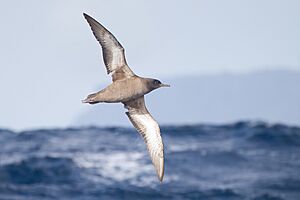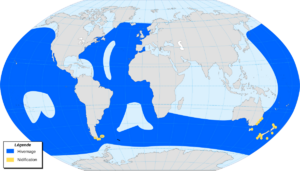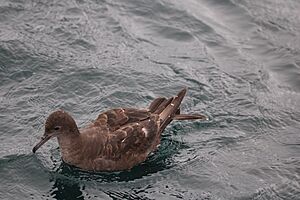Sooty shearwater facts for kids
Quick facts for kids Sooty shearwater |
|
|---|---|
 |
|
| Sooty shearwater off Tasmania | |
| Conservation status | |
| Scientific classification | |
| Genus: |
Ardenna
|
| Species: |
grisea
|
 |
|
| Range of the sooty shearwater in dark blue and breeding sites in yellow | |
The sooty shearwater (Ardenna grisea) is a medium-sized seabird that belongs to the shearwater family. In New Zealand, people also call it tītī, which is its Māori name. The Māori people traditionally gather these birds, much like their relatives, the wedge-tailed shearwater and the Australian short-tailed shearwater, for food and oil. This practice is known as muttonbirding.
Contents
About the Sooty Shearwater's Name
Scientists give every animal a special two-part name. The sooty shearwater got its first scientific description in 1789. A German scientist named Johann Friedrich Gmelin gave it the name Procellaria grisea.
Before that, in 1777, James Cook briefly described the bird during his second trip to the Pacific. Another English bird expert, John Latham, also described a museum bird in 1785. But neither of them gave it a proper scientific name.
Today, the sooty shearwater is in a group called Ardenna. This group name comes from an old word for a seabird. The second part of its name, grisea, is a Latin word meaning "grey." This bird is unique and does not have any different types or subspecies.
What Does the Sooty Shearwater Look Like?
Sooty shearwaters are about 40 to 51 centimeters (16 to 20 inches) long. Their wings can spread out to about 94 to 110 centimeters (37 to 43 inches) wide. They fly in a special way, dipping from side to side with stiff wings. Their wingtips often almost touch the water.
Their flight is strong and direct. They hold their wings straight, which makes them look a bit like a very small albatross. You can easily spot this bird by its dark feathers, which is why it is called "sooty."
When it is hard to see, the bird looks completely black. But in good light, you can see it is a dark chocolate-brown color. It also has a shiny, silvery stripe along the middle of its underwing.
These birds make loud cooing and croaking sounds at night. This happens when they are in their breeding areas. When they are out at sea, they are usually quiet. However, they might call out if they are fighting for food in a big group.
Where Do Sooty Shearwaters Live and Travel?


Sooty shearwaters build their nests on small islands. They have two main groups. One group lives in the southern Pacific Ocean. This is mostly around southeast Australia, New Zealand, and islands like the Auckland Islands.
The other group lives in the southern Atlantic Ocean. These birds are found on the Falkland Islands, Tierra del Fuego, and Tristan da Cunha. They start laying eggs in October. The parents sit on the eggs for about 54 days. After the chick hatches, the parents care for it for 86 to 109 days.
These birds are amazing long-distance travelers. They fly in a huge circle across the oceans. After nesting, they fly north along the western sides of the Pacific and Atlantic Oceans. This happens from March to May.
They reach colder northern waters in June and July. Then, they fly east across the ocean. From September to October, they fly south down the eastern sides of the oceans. They arrive back at their breeding islands in November. They do not fly in one big group. Instead, they travel alone and only meet up by chance.
In the Atlantic Ocean, they fly over 14,000 kilometers (8,700 miles). They go from the Falkland Islands all the way north to Norway. Birds from New Zealand have been tracked flying 74,000 kilometers (46,000 miles) in a year! They reach places like Japan, Alaska, and California. That is more than 500 kilometers (310 miles) every day.
What Do Sooty Shearwaters Eat and How Do They Nest?
Sooty shearwaters mostly eat fish and squid. They can dive deep, up to 68 meters (223 feet), to find food. But they often eat food floating near the surface. They sometimes follow whales to catch fish that the whales stir up. They also follow fishing boats to eat fish scraps.
These birds nest in very large groups. The female lays one white egg. The egg is usually about 48 millimeters (1.9 inches) wide and 77.5 millimeters (3.1 inches) long.
They build their nests in burrows (tunnels in the ground). They line these burrows with plants. They only visit their burrows at night. This helps them avoid being caught by large gulls and skuas. The way their burrows are built can change. This depends on how much space there is and what kind of ground they are digging in.
In New Zealand, about 250,000 young birds are gathered each year. The Māori people do this for food and oil. This traditional practice is called muttonbirding. The young birds are taken from their burrows, their feathers are removed, and they are often kept in salt. Sadly, climate change is now affecting this important cultural harvest.
The number of sooty shearwaters has been going down in recent years. Because of this, they are now listed as "near threatened" by a group called the IUCN.
The Sooty Shearwater and The Birds Movie
On August 18, 1961, something strange happened in California. Thousands of sooty shearwaters were seen acting very oddly. They were throwing up anchovies, flying into buildings, and dying in the streets. A local resident, Alfred Hitchcock, heard about this event.
This strange bird behavior, along with a story by writer Daphne du Maurier, helped inspire Hitchcock's famous 1963 movie, The Birds. This movie is a scary story about nature fighting back against people. It is now one of the top thrillers ever made.
Scientists later looked at what was in the stomachs of sea turtles and seabirds from that time. They found that tiny plants called algae were making a poison. This poison was in 79% of the plankton that the animals ate. Scientists believe the birds were poisoned. The symptoms matched other bird poisoning events in the same area.
One expert thinks that leaky septic tanks might have caused the problem. These tanks were built during a housing boom in the early 1960s. They might have fed the toxic algae. Scientists now watch for these poisons to help protect wildlife.




